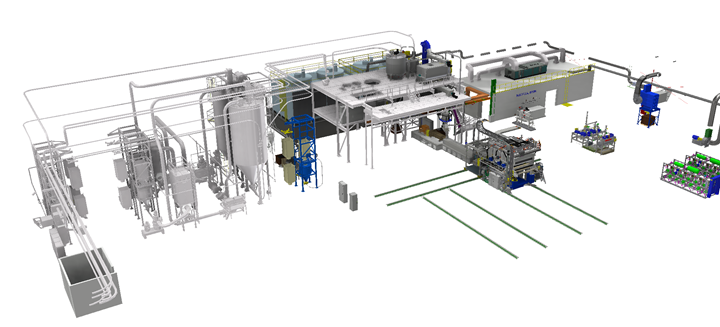From 0 to 1: Building a Compounding Extrusion Production Line—Unveiling the Full Process from Planning to Commissioning
Adding a new compounding extrusion production line is a complex system engineering project, yet it can bring significant benefits. This requires a holistic approach to the project, comprehensively evaluating factors such as plant space, budget investment, and manpower allocation. The primary decision is whether to choose a single extruder assembled independently or to purchase a turnkey solution that includes a complete set of components.
1. Key Assessments Before Project Initiation
If a company already has experience operating extrusion production lines, it will have an advantage when setting up a new line. However, even seasoned compounding enterprises should be cautious of potential risks—for example, when producing pellet products with a new formulation for the first time, process compatibility may become a barrier to commissioning. At this point, it is necessary to balance process complexity with capacity expansion needs.
If the material demand is small and internal technology is mature, you can independently purchase an extruder and integrate the remaining compounding equipment yourself.
Turnkey solution: When the process involves multi-component coordination (such as 8-9 materials in loss-in-weight feeding), it is recommended to choose a full-process supplier, with supporting jacketed structures and material handling systems.
Taking a basic production line as an example, producing pellets containing color masterbatch requires only 5-6 types of raw materials to be fed into the extruder through a single feeder. Such production lines can be quickly replicated based on internal experience. In contrast, complex compounding processes that are completed entirely within the extruder must rely on engineering support from specialized suppliers.
2. Core Logic of Extruder Selection
As the heart of the production line, the selection of the extruder screw diameter needs to be combined with production capacity and raw material costs.
27mm screw: The ideal model for laboratory settings, suitable for small-scale research and development.
33-53mm screw: The most mainstream production model, suitable for most conventional production.
73-103mm screw: Large-scale granulation with an annual capacity of hundreds of thousands of pounds, requires a high-power motor.
The small-sized extruder shows significant advantages during the trial production phase: it produces less waste, making it especially suitable for high-cost raw materials; its changeover and cleaning efficiency are higher, making it ideal for multi-variety small-batch production.
3. Factory Renovation and Infrastructure Adaptation

A comprehensive evaluation of site conditions is required for the new production line.
Layer height requirement: 33-53mm extruders are compatible with standard factory buildings; for models with heights above 73mm, additional consideration must be given to the installation height of material lifting equipment.
Hydropower load: Large extruders (such as 73mm models equipped with 600-horsepower motors) often require additional transformers. This expense may lead companies to choose 53mm models to reduce renovation costs.
4. Selection of Installation Execution Strategies
The production line integration model directly affects implementation efficiency.
Decentralized procurement: Purchasing extruders, pelletizers, and other equipment from different suppliers separately, but it is necessary to address the communication compatibility issues between multi-brand equipment.
Turnkey procurement: A single supplier provides end-to-end equipment, which can significantly reduce system integration risks.
5. Precise Control of the Feeding System
In a dual feeder scenario, formula stability is particularly crucial. For example, a ratio of 50% calcium carbonate + 50% polyolefin may lead to component deviations of up to ±10% if the feeder selection is inappropriate. Core principles include:
Loss-in-weight feeding preferred: standard configuration for most compounding lines.
Material compatibility: Powder materials require specialized feeders, while some models can accommodate granular materials by replacing the sieve.
Anti-sticking design: For easily agglomerated particles, a stirring function needs to be provided.
VI. Key Points of Equipment Maintenance
The extruder barrel and screw are the main wear components, and calibration deviation can lead to metal friction wear. It is recommended to establish a preventive maintenance mechanism.
Regular laser alignment inspection.
Access wear monitoring tool.
Follow the supplier's maintenance schedule (such as the transmission oil replacement interval).
7. The Golden Rules for Supplier Selection
An ideal supplier should possess full-chain technical capabilities, with particular emphasis on the following areas for assessment:
Predictive testing capability: ability to optimize equipment selection through material trial processing;
Understanding of granulation processes: suitable scenarios for underwater pelletizing and water strand pelletizing.
Quick Changeover Design: Whether solutions such as quick die/head change are provided to improve efficiency.
【Copyright and Disclaimer】The above information is collected and organized by PlastMatch. The copyright belongs to the original author. This article is reprinted for the purpose of providing more information, and it does not imply that PlastMatch endorses the views expressed in the article or guarantees its accuracy. If there are any errors in the source attribution or if your legitimate rights have been infringed, please contact us, and we will promptly correct or remove the content. If other media, websites, or individuals use the aforementioned content, they must clearly indicate the original source and origin of the work and assume legal responsibility on their own.
Most Popular
-

EVA Morning Prices on September 12: Most of the Market Holds Steady, Highest Rise of 50 Yuan
-

[PET Weekly Outlook] Polyester Bottle Chips Expected to Oscillate and Warm Up with Costs Today
-

Top Ten Personnel Changes in the Auto Industry: Insights into Industry Anxiety and Progress | Vision 2025
-

List Released! Mexico Announces 50% Tariff On 1,371 China Product Categories
-

Domo Chemicals Files for Bankruptcy Protection in Germany! B. Braun Launches New Supply Assurance Program






